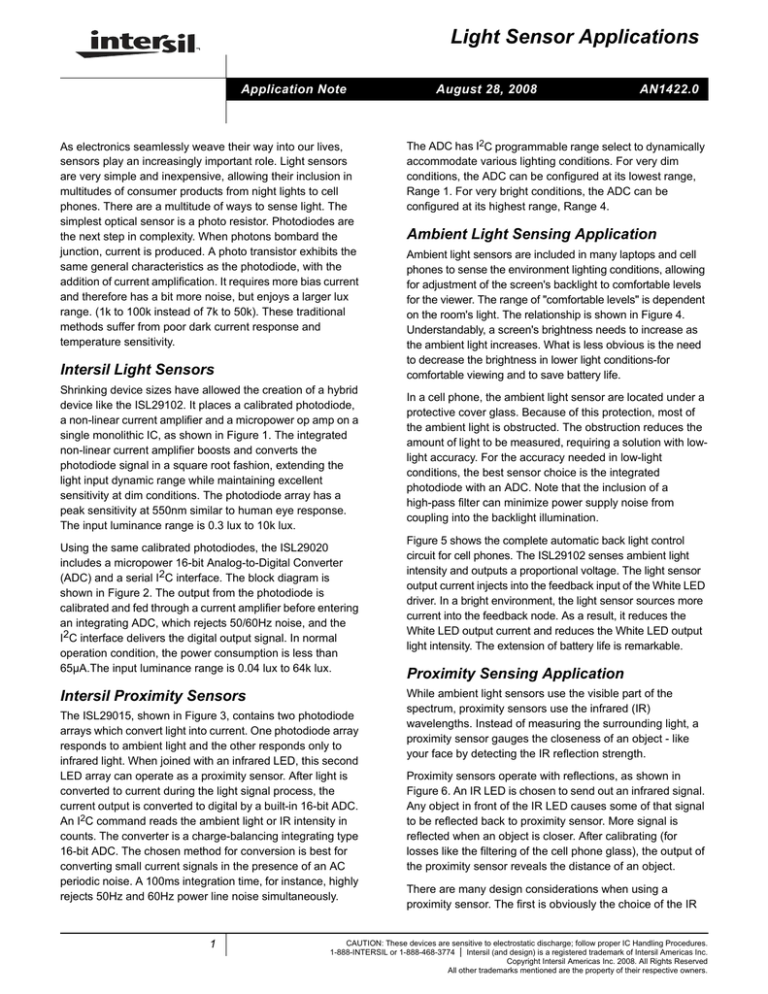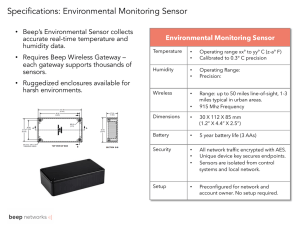
Light Sensor Applications
¬
Application Note
As electronics seamlessly weave their way into our lives,
sensors play an increasingly important role. Light sensors
are very simple and inexpensive, allowing their inclusion in
multitudes of consumer products from night lights to cell
phones. There are a multitude of ways to sense light. The
simplest optical sensor is a photo resistor. Photodiodes are
the next step in complexity. When photons bombard the
junction, current is produced. A photo transistor exhibits the
same general characteristics as the photodiode, with the
addition of current amplification. It requires more bias current
and therefore has a bit more noise, but enjoys a larger lux
range. (1k to 100k instead of 7k to 50k). These traditional
methods suffer from poor dark current response and
temperature sensitivity.
Intersil Light Sensors
Shrinking device sizes have allowed the creation of a hybrid
device like the ISL29102. It places a calibrated photodiode,
a non-linear current amplifier and a micropower op amp on a
single monolithic IC, as shown in Figure 1. The integrated
non-linear current amplifier boosts and converts the
photodiode signal in a square root fashion, extending the
light input dynamic range while maintaining excellent
sensitivity at dim conditions. The photodiode array has a
peak sensitivity at 550nm similar to human eye response.
The input luminance range is 0.3 lux to 10k lux.
Using the same calibrated photodiodes, the ISL29020
includes a micropower 16-bit Analog-to-Digital Converter
(ADC) and a serial I2C interface. The block diagram is
shown in Figure 2. The output from the photodiode is
calibrated and fed through a current amplifier before entering
an integrating ADC, which rejects 50/60Hz noise, and the
I2C interface delivers the digital output signal. In normal
operation condition, the power consumption is less than
65µA.The input luminance range is 0.04 lux to 64k lux.
Intersil Proximity Sensors
The ISL29015, shown in Figure 3, contains two photodiode
arrays which convert light into current. One photodiode array
responds to ambient light and the other responds only to
infrared light. When joined with an infrared LED, this second
LED array can operate as a proximity sensor. After light is
converted to current during the light signal process, the
current output is converted to digital by a built-in 16-bit ADC.
An I2C command reads the ambient light or IR intensity in
counts. The converter is a charge-balancing integrating type
16-bit ADC. The chosen method for conversion is best for
converting small current signals in the presence of an AC
periodic noise. A 100ms integration time, for instance, highly
rejects 50Hz and 60Hz power line noise simultaneously.
1
August 28, 2008
AN1422.0
The ADC has I2C programmable range select to dynamically
accommodate various lighting conditions. For very dim
conditions, the ADC can be configured at its lowest range,
Range 1. For very bright conditions, the ADC can be
configured at its highest range, Range 4.
Ambient Light Sensing Application
Ambient light sensors are included in many laptops and cell
phones to sense the environment lighting conditions, allowing
for adjustment of the screen's backlight to comfortable levels
for the viewer. The range of "comfortable levels" is dependent
on the room's light. The relationship is shown in Figure 4.
Understandably, a screen's brightness needs to increase as
the ambient light increases. What is less obvious is the need
to decrease the brightness in lower light conditions-for
comfortable viewing and to save battery life.
In a cell phone, the ambient light sensor are located under a
protective cover glass. Because of this protection, most of
the ambient light is obstructed. The obstruction reduces the
amount of light to be measured, requiring a solution with lowlight accuracy. For the accuracy needed in low-light
conditions, the best sensor choice is the integrated
photodiode with an ADC. Note that the inclusion of a
high-pass filter can minimize power supply noise from
coupling into the backlight illumination.
Figure 5 shows the complete automatic back light control
circuit for cell phones. The ISL29102 senses ambient light
intensity and outputs a proportional voltage. The light sensor
output current injects into the feedback input of the White LED
driver. In a bright environment, the light sensor sources more
current into the feedback node. As a result, it reduces the
White LED output current and reduces the White LED output
light intensity. The extension of battery life is remarkable.
Proximity Sensing Application
While ambient light sensors use the visible part of the
spectrum, proximity sensors use the infrared (IR)
wavelengths. Instead of measuring the surrounding light, a
proximity sensor gauges the closeness of an object - like
your face by detecting the IR reflection strength.
Proximity sensors operate with reflections, as shown in
Figure 6. An IR LED is chosen to send out an infrared signal.
Any object in front of the IR LED causes some of that signal
to be reflected back to proximity sensor. More signal is
reflected when an object is closer. After calibrating (for
losses like the filtering of the cell phone glass), the output of
the proximity sensor reveals the distance of an object.
There are many design considerations when using a
proximity sensor. The first is obviously the choice of the IR
CAUTION: These devices are sensitive to electrostatic discharge; follow proper IC Handling Procedures.
1-888-INTERSIL or 1-888-468-3774 | Intersil (and design) is a registered trademark of Intersil Americas Inc.
Copyright Intersil Americas Inc. 2008. All Rights Reserved
All other trademarks mentioned are the property of their respective owners.
Application Note 1422
VDD
1
LIGHT DATA
PROCESS
ALS AND IR
A second set of design considerations are concerned with
mechanical issues. For example, how well is the IR LED
isolated from the sensor? Any leakage will taint the readings.
Both the placement of the components and any obstructions
(purposeful or incidental) need to be considered. Additionally,
there is usually a panel of glass to protect the electronics and
the user from each other. That cover glass has its own filtering
spectrum that must be included in the design.
+
CURRENT
AMPLIFIER
LIGHT DATA
PROCESS
VOUT
6
5 SDA
SHDN
I2C
EXT
TIMING
4 SCL
FOSC
216
COUNTER
IR DRIVER
6 IRDR
2
3
REXT
GND
FIGURE 3. BLOCK DIAGRAM OF ISL29015, AMBIENT
LIGHT SENSOR AND PROXIMITY SENSOR
100000
DISPLAY IS TOO BRIGHT - READABLE, BUT ANNOYING
10000
1000
100
OPTIMUM
VISUAL
COMFORT
10
1
CAR
0.1
HOME
0.01
0.001
OFFICE
DAYLIGHT
DISPLAY IS TOO DARK - NOT READABLE
0.1
OUTPUT CURRENT α √LIGHT INTENSITY
1
10
100
1k
10k
100k
AMBIENT ILLUMINATION - LUX
FIGURE 4. GRAPH OF DESIRED BRIGHTNESS WITH
RESPECT TO AMBIENT ILLUMINATION
PHOTODIODE
ARRAY
GND
2
DATA
REGISTER
IREF
LCD BRIGHTNESS cd/m2
VDD
1
COMMAND
REGISTER
INTEGRATING
ADC
IR PHOTODIODE
ARRAY
Conclusion
A wide variety of optical sensors are available in small
packages at reasonable prices. Passive solutions have been
serving consumers for decades in night lights and still digital
cameras. Active solutions have increased the range and
usefulness of ambient light sensors. Typical active solutions
integrate a photo transistor or a photodiode with a current
amplifier. When greater resolution, low-light capability, power
supply rejection, or a disabling function would be useful, the
Intersil ISL29xxx family extends the usefulness of typical
ambient light sensors.
IN TIME
PHOTODIODE
ARRAY
RANGE
LED to be used. The second is the composition of the object
to be sensed. Most sensors are calibrated with one of the
standard reflective surfaces, like 18% reflective gray paper.
More signal will be returned to the sensor if the surface has a
higher reflectivity.
4 REXT
FIGURE 1. BLOCK DIAGRAM OF ISL29102 AMBIENT LIGHT
SENSOR WITH INTEGRATED AMPLIFIER
PHOTODIODE
ARRAY
LIGHT
DATA
PROCESS
IREF
BACKLIGHT
CONTROL
ALGORITHM
LED DRIVER
OR CCFL
BACKLIGHT
POWER
CONTROL
LED
OR CCFL
LAMP
FIGURE 5. BLOCK DIAGRAM OF LIGHT SENSING SYSTEM
IN A LAPTOP OR CELL PHONE
SHDN
INT TIME
MODE
GAIN/RANGE
VDD
1
LIGHT
SENSOR
COMMAND
REGISTER
INTEGRATING
ADC
EXT
TIMING
DATA
REGISTER
I2C/SMBus
5 SCL
6 SDA
fOSC
216
COUNTER
3
REXT
2
GND
4
A0
FIGURE 2. BLOCK DIAGRAM OF ISL29020, AMBIENT LIGHT
SENSOR WITH ADC, AND I2C INTERFACE
FIGURE 6. APPLICATION DIAGRAM OF PROXIMITY SENSOR
Intersil Corporation reserves the right to make changes in circuit design, software and/or specifications at any time without notice. Accordingly, the reader is cautioned to
verify that the Application Note or Technical Brief is current before proceeding.
For information regarding Intersil Corporation and its products, see www.intersil.com
2
AN1422.0
August 28, 2008
1M


